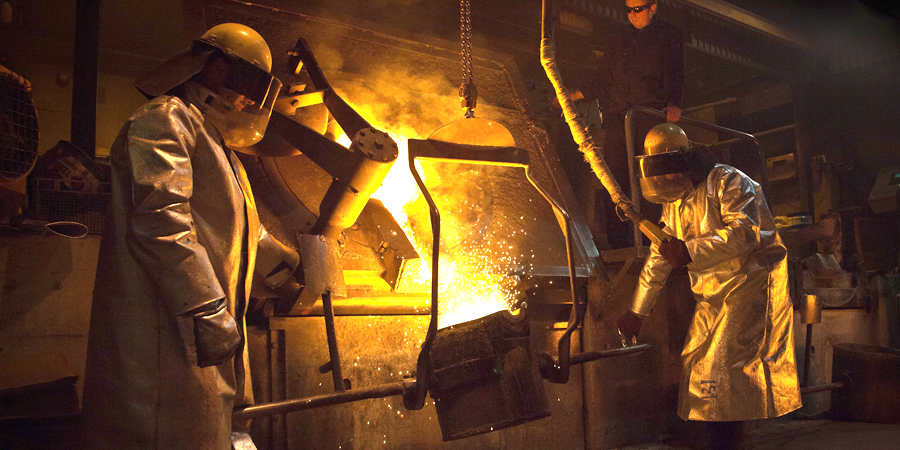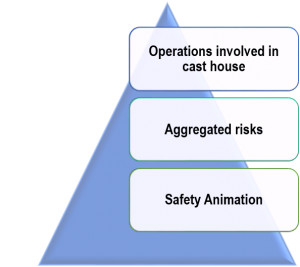Cast House Operations For Metallurgy

To develop elevated standards of safety, metallurgy industry is probably one of the toughest because high-risk operations are carried on a regular basis. The hazards range from noise to physical to chemical and ergonomics, plus there are many active machines in one workspace. The safety and health risks can be offset and managed via better job-specific training delivery – via innovative safety animation approaches.
Cast-house operations form a substantial part as this is an area where the molten metal is directed from the blast furnace to the torpedo ladle cars.

For low-cost Blast Furnace (BF) operations, a good and trouble-free cast house is important. Primarily because in the entire BF lifecycle, cast house is the most labor intensive area; there are troughs, runners and equipment involved. The transfer operations that involve the molten metal require efficiency in working for greater outputs. The key to an excellent cast house operation is high casting rate (to reduce the consumable material i.e. molten metal) and the up keeping of the hearth of the Blast Furnace (in a dry state).
The necessity of the efficiency of the whole process can be emphasized through animation. Videos can depict the considerations for the cast house operations and educate the workmen prior to beginning of any task. Portraying the importance and the mindset behind such actions helps them deal better with those processes.
For proper cast-house operations, certain things need to be observed. Primary being its:
- Functional design
- Operational practices
- Refractory technology
- Automation and environmental requirements
Animation can one-by-one highlight and explain the purpose behind the considerations; accommodate them by scenarios, and other such approaches.
For e.g. ideally, a cast house, by layout, should have enough space to accommodate both workmen and equipment, should have entrances, passages and exits in times of emergencies. With tilting or swinging runners, high capacity hot metal ladles, cranes, forklifts, handling trucks, dust and fume extraction processes, slag granulation processes, a cast house has all of it.
Here, through animation, one can propose a very simple-to-build area plan – one that is easy to understand and solves the safety concerns for this industry. With this knowledge, visualizations for workmen become easy, they are well-introduced to the area they are working in. In cast-houses, it can demonstrate the various safety aspects for a specific process.
A steel-mill scenario
To understand this better, imagine a steel mill, and an operator working by the Blast Furnace. He was monitoring the raw material supply (molten iron and air). While he was operating, the level of the molten iron rose above the fire brick lining. Its high temperature led to melting of the steel shell and flowed out of the furnace. The metal came into contact with the cooling water receiver outside the bottom of the furnace, which led to a steam explosion.
The above incident can be aptly depicted through animation. Such incidents are the handling inefficiencies while working – their know-how becomes necessary for a worker to handle tasks and work with care. Plus, the animation approach is feasible as one can be a part of a situation – can experience ‘near-exact’ look and feel and explaining risks and hazards becomes easy.
The primary cause of the accident was the temperature difference (led to solidification of molten iron) between the bottom and the top of the Blast Furnace. The resulting damages included injury of the operator, monetary damages, scattering materials (molten iron, slag), water furnace and a melting furnace (became unusable).
Likewise, in a cast house, there are high chances of explosions due to
- Steam formations
- Reactions between molten metal and contaminants
- Ignition of gases and dust
So, to explain a personnel’s behavior and approach, animation is the answer because it can elaborately explain the cause and effects of the incidents through visuals, voiceovers and other techniques. Also, with a 360 degree reversal, the incident can be recreated with correct procedures to provide clarity.
Safety valves, temperature recorders are the countermeasures to be considered while planning, design and manufacture of the devices. Animation has the ability to capture the finest details; it can help viewers analyze, record and track changes, thus they stay oriented across the transitions.
While working in such a high-risk, it is important to take necessary precautions to prevent incidents. This can comprise of following S.O.Ps, maintaining best house-keeping standards and equipment in best possible conditions. Animation is the factor that complements trainings and delivers information very well.
Hazard evaluation is essential for preventing health and safety issues in an aluminium cast house operations. Quality-driven cast house managers are aware that, in order to ensure employee safety, all potential risks associated with an aluminium cast house must be discussed and trained upon, not just the risks associated with a given employee’s particular job duties.
Safety becomes the core of a casthouse’s operations when all team members follow standard operating procedures correctly and consistently, which greatly reduces the likelihood of an incident. If the means of training needs to be opted, it can be safety animation.
There are risks in almost every employment, regardless of the field you work in. The hazards will increase in proportion to how dangerous the job is, and working with molten aluminium is no exception.
Working in a casthouse in metallurgy requires special precautions due to the molten aluminum’s extremely reactive (and explosive) nature.
It is crucial for plant managers and owners to comprehend how to recognise hazards, evaluate the risks involved, and decide how to effectively control those risks in their day-to-day activities.
A single negligent action could halt operations or possibly take lives.
In the next write-up, we will learn how man and operations jointly increase the risks for both – industry and the workmen.


